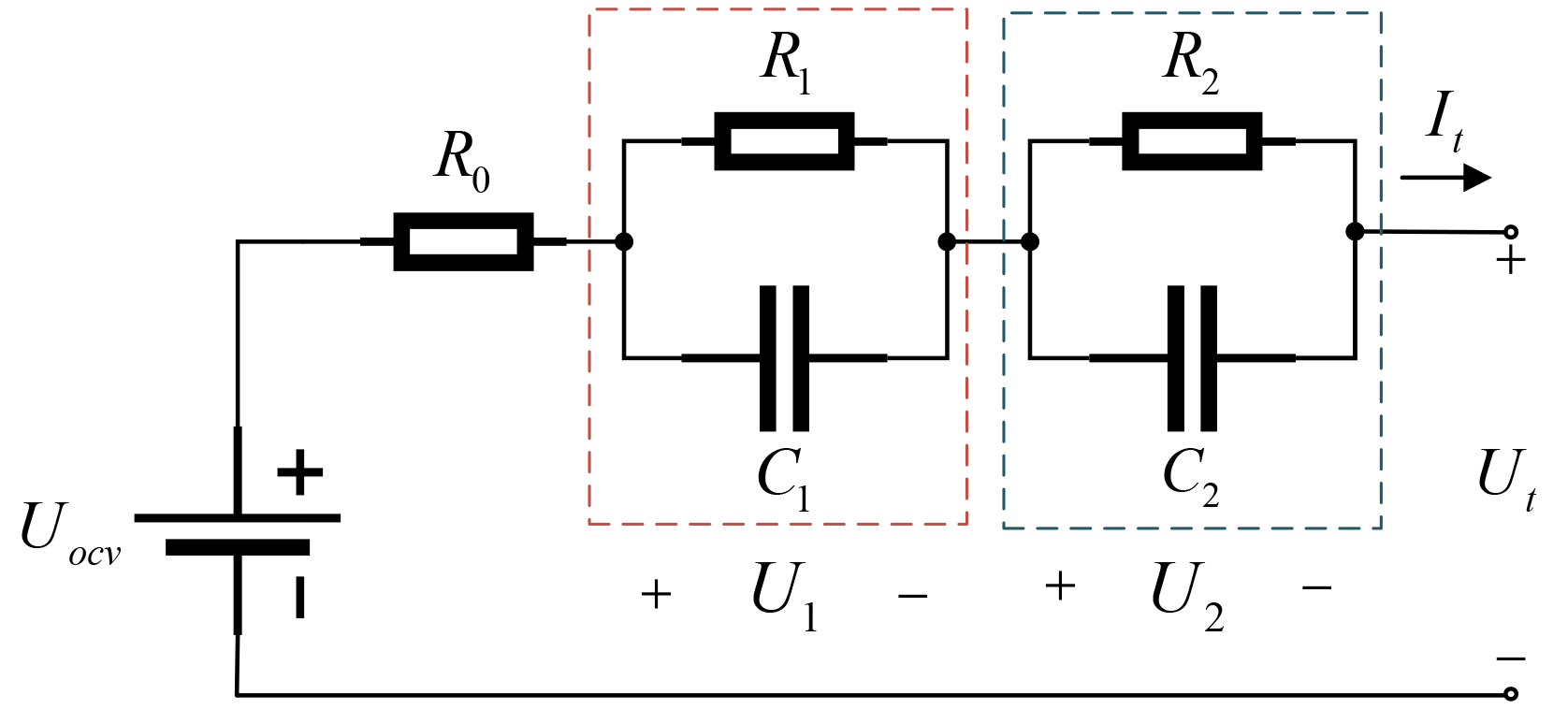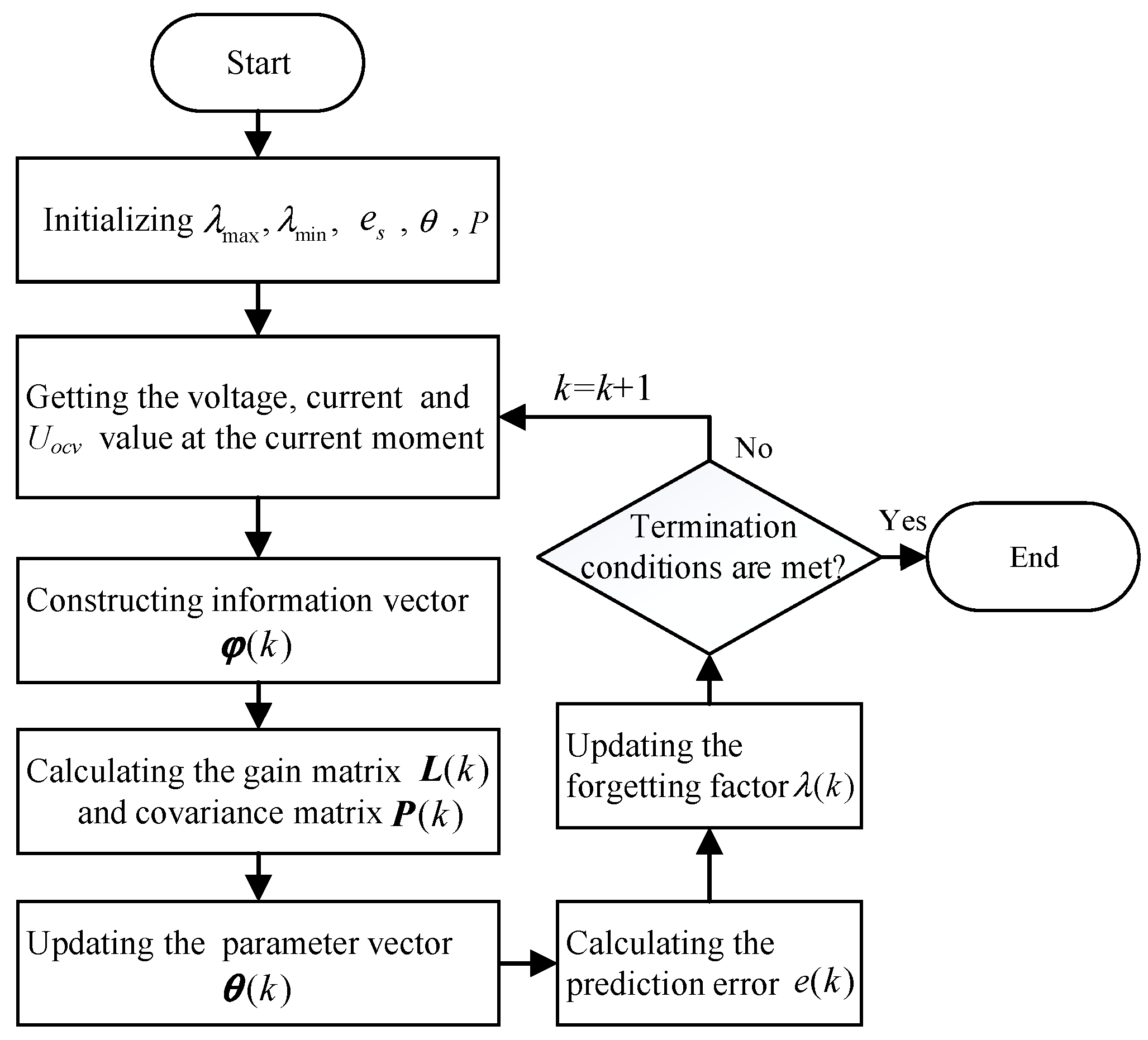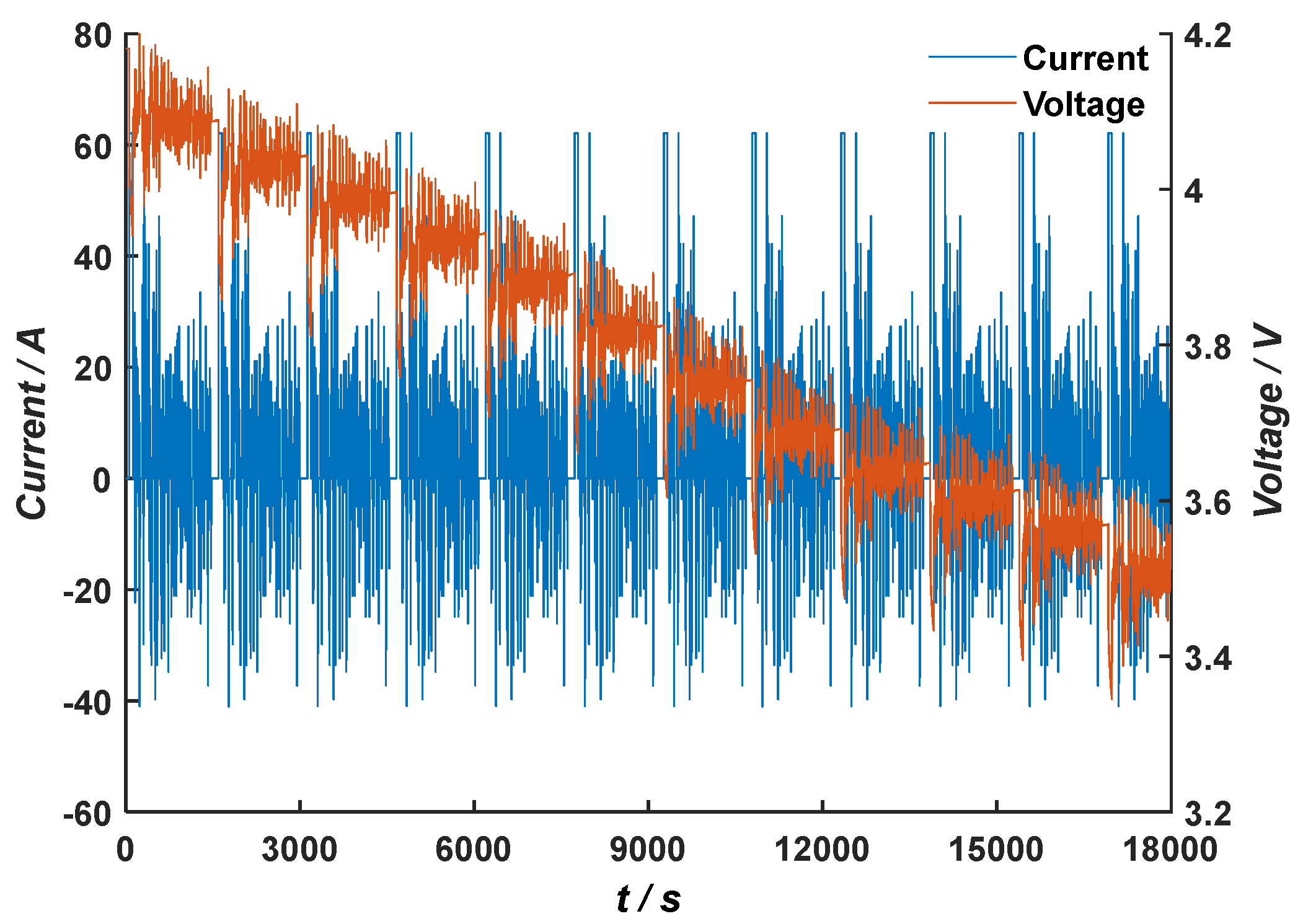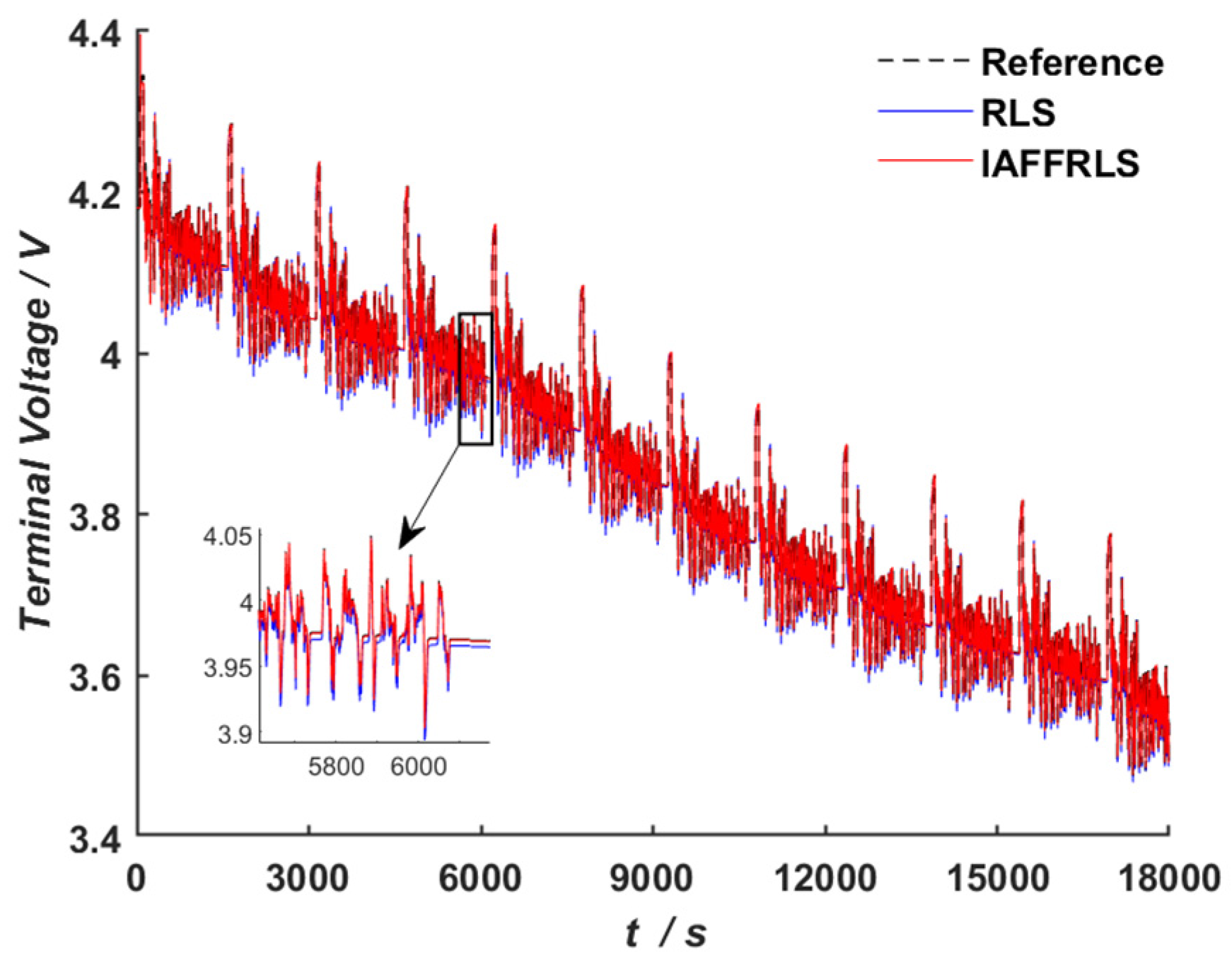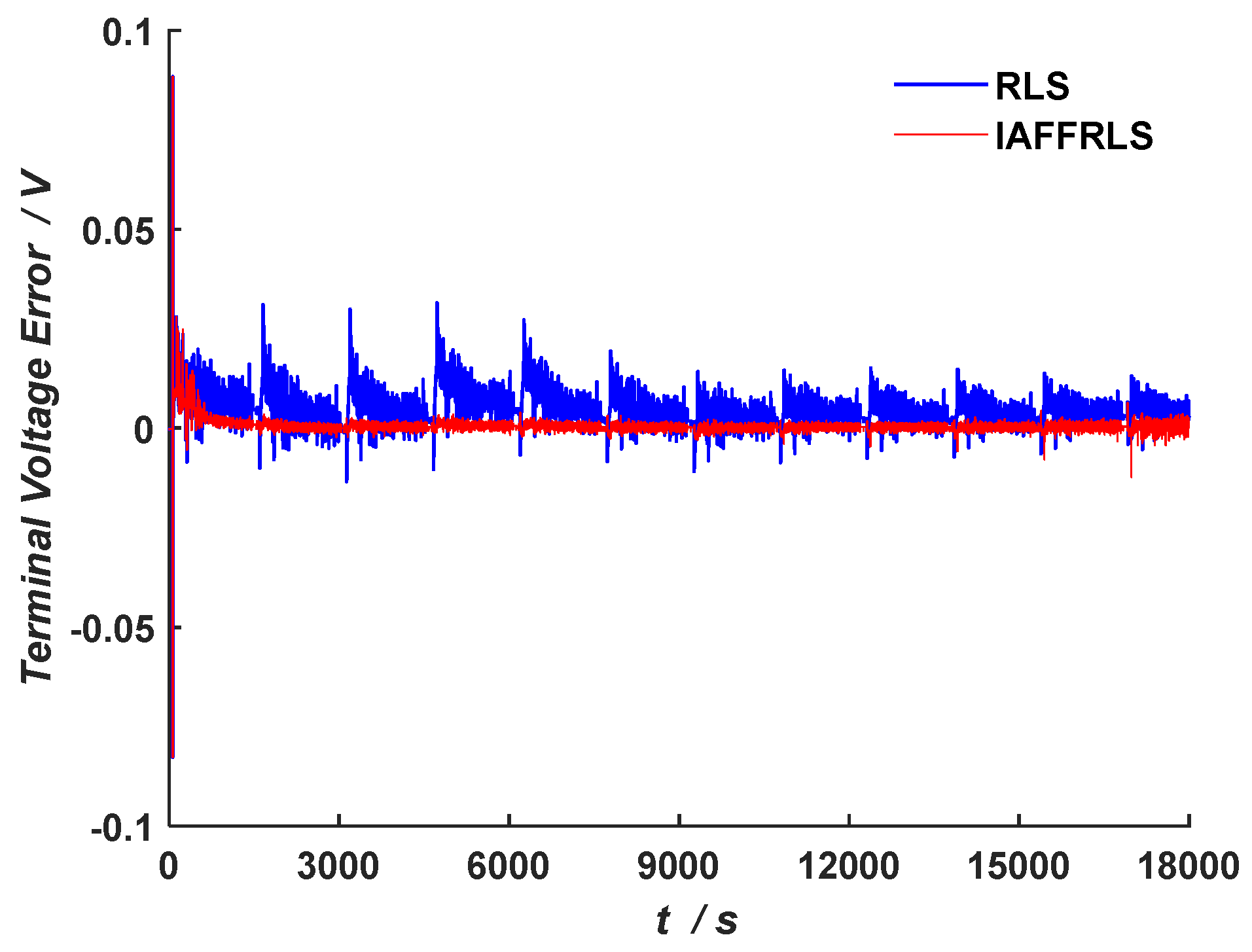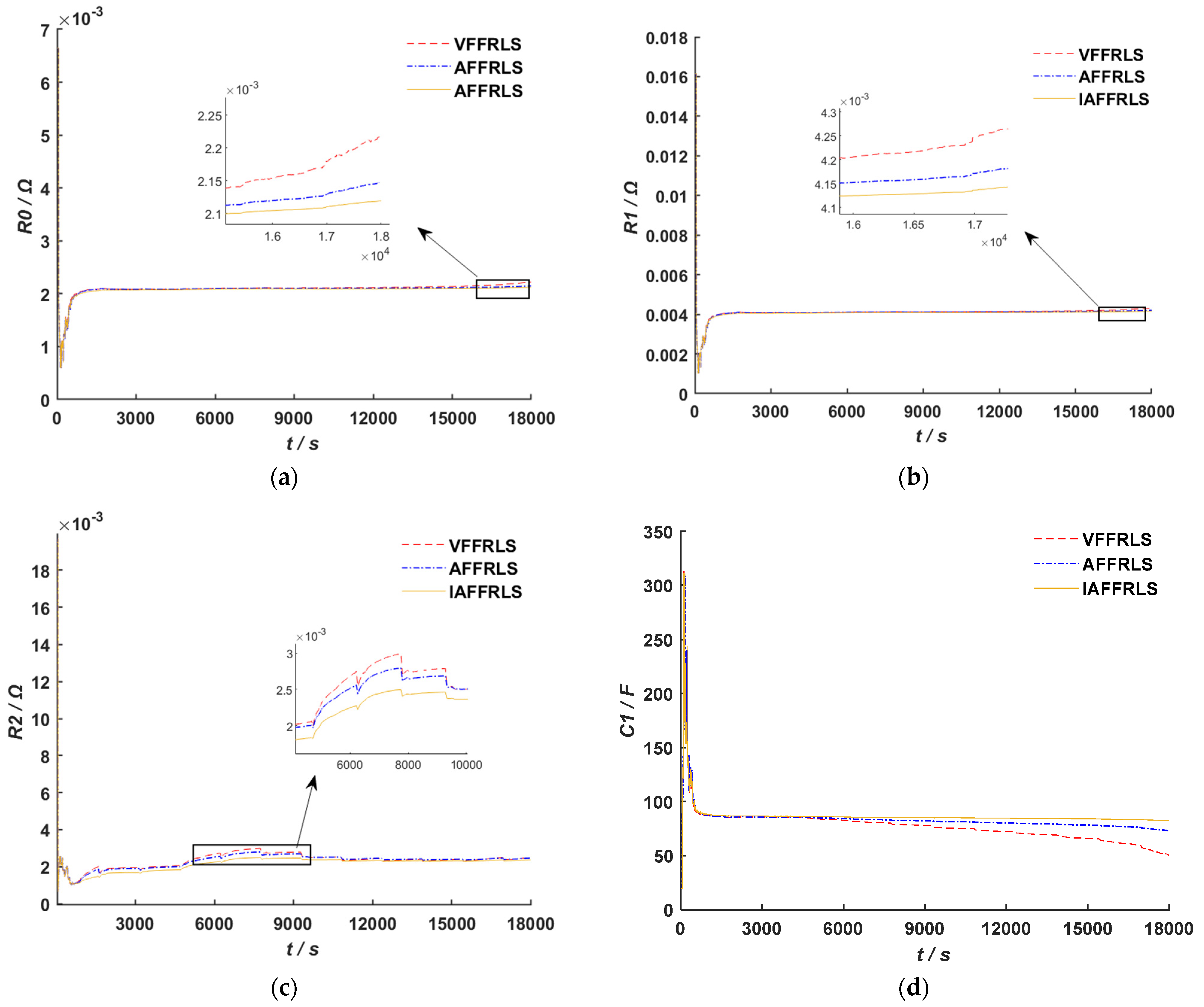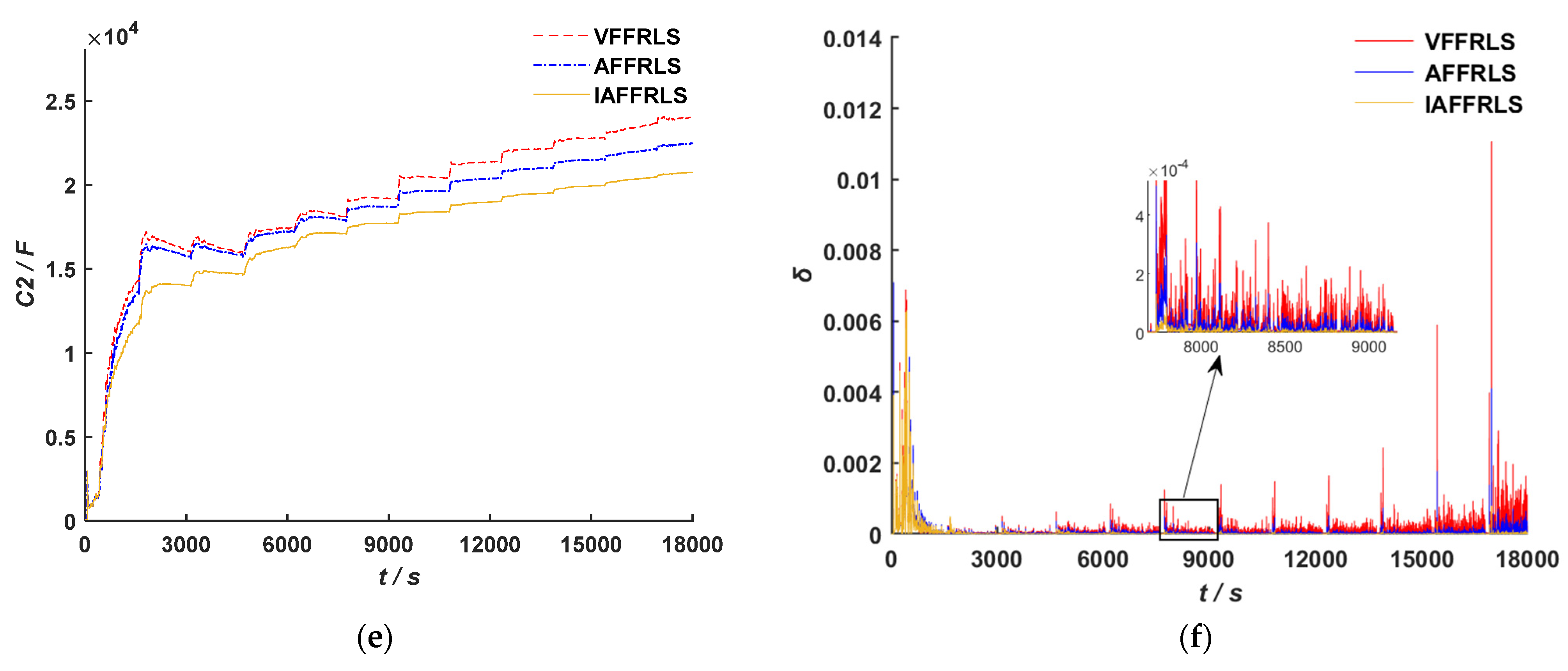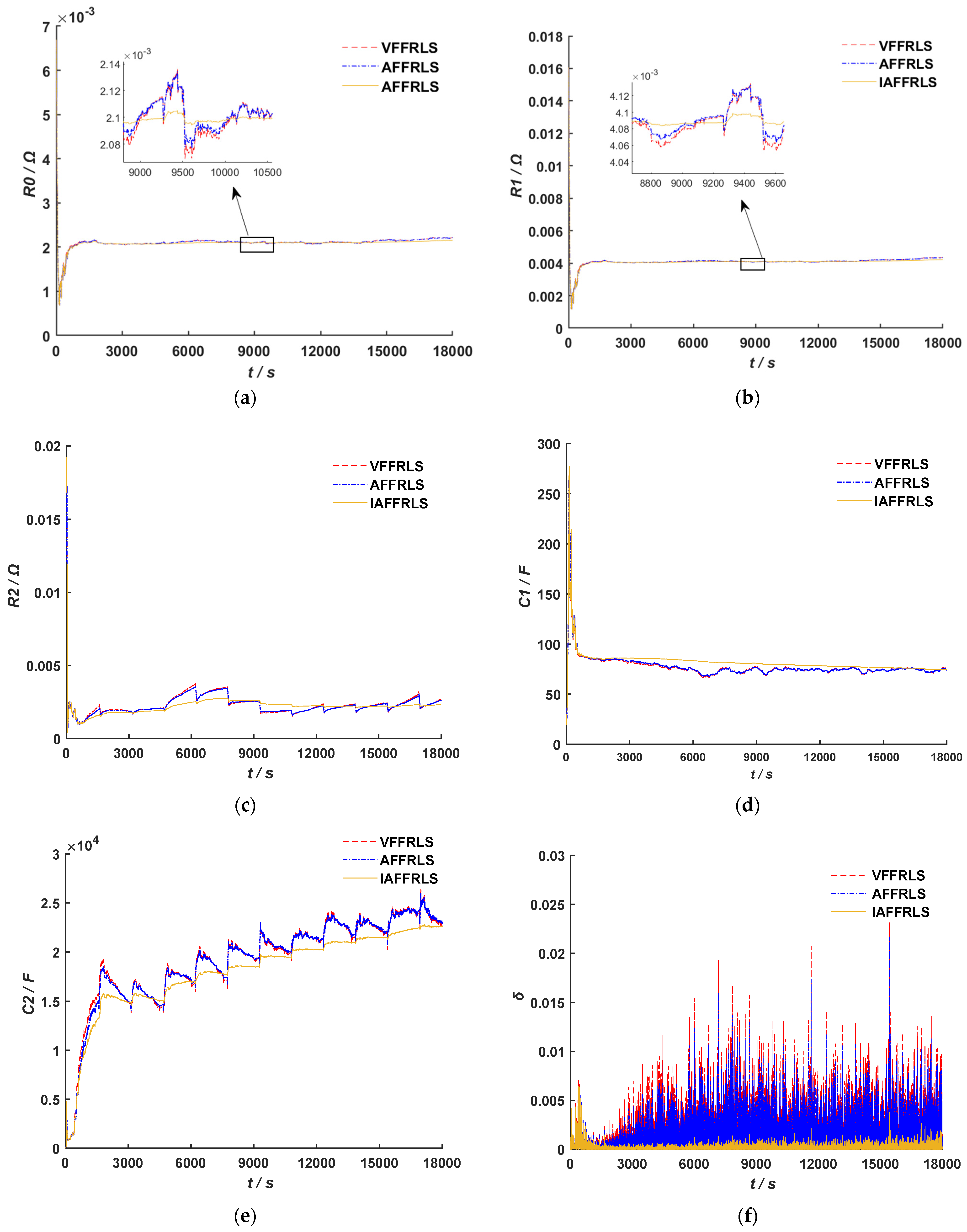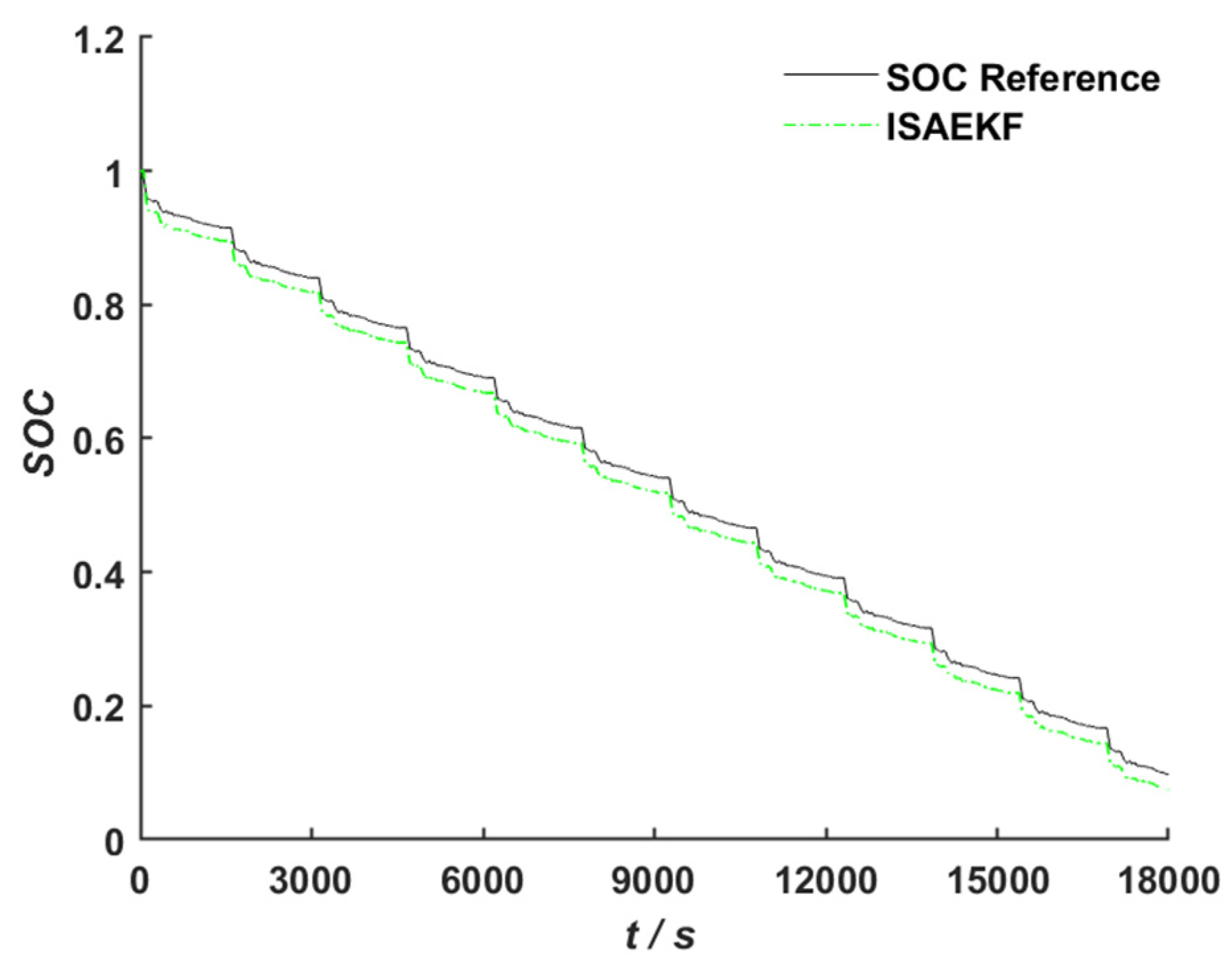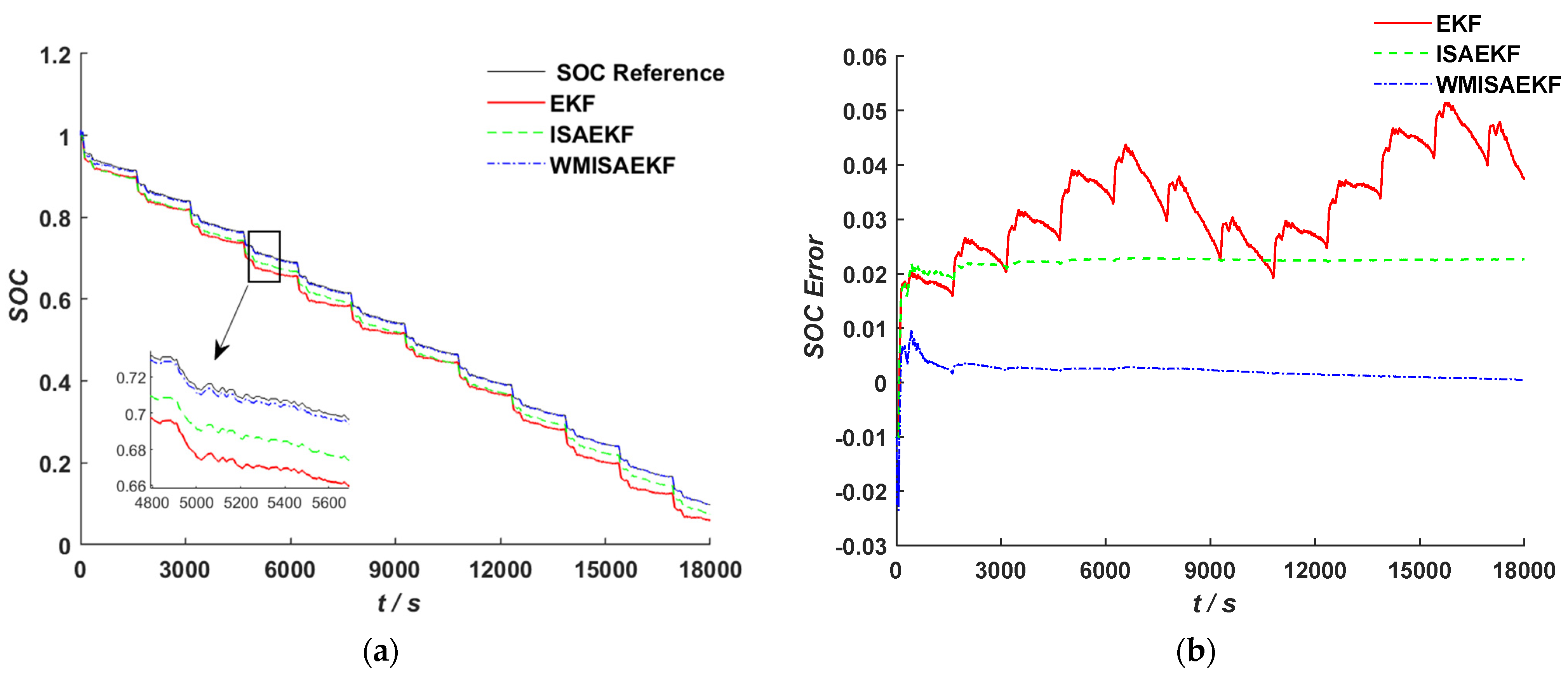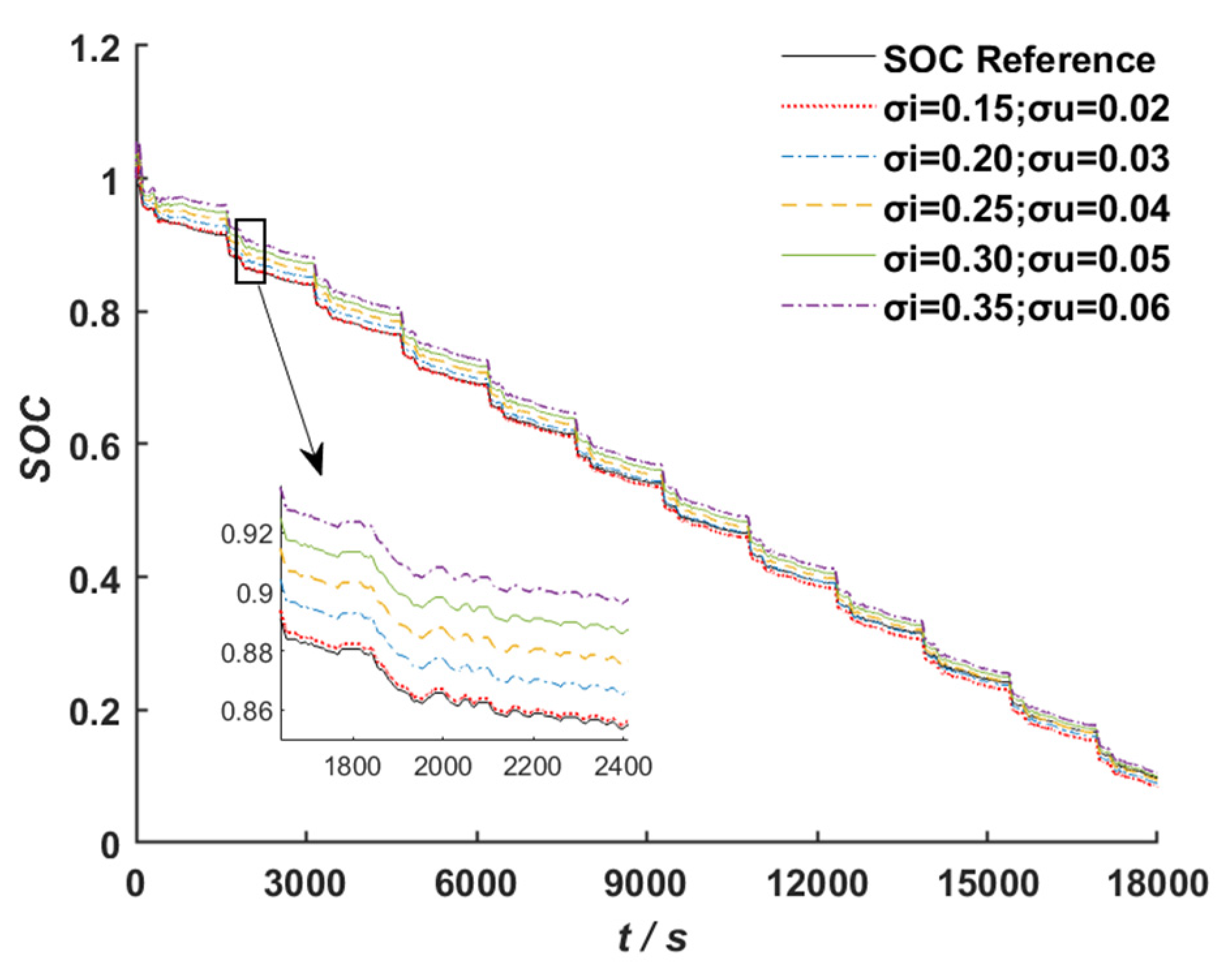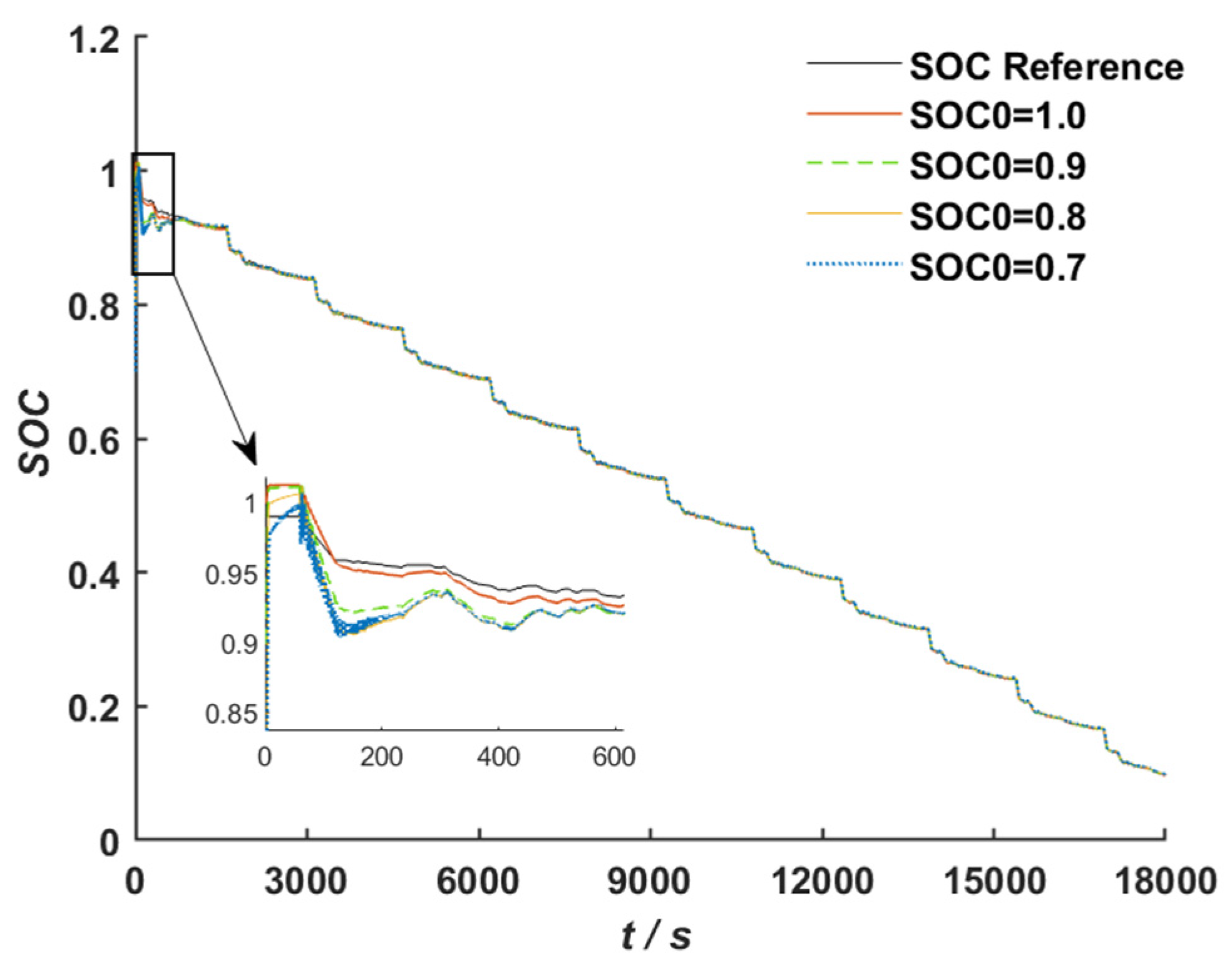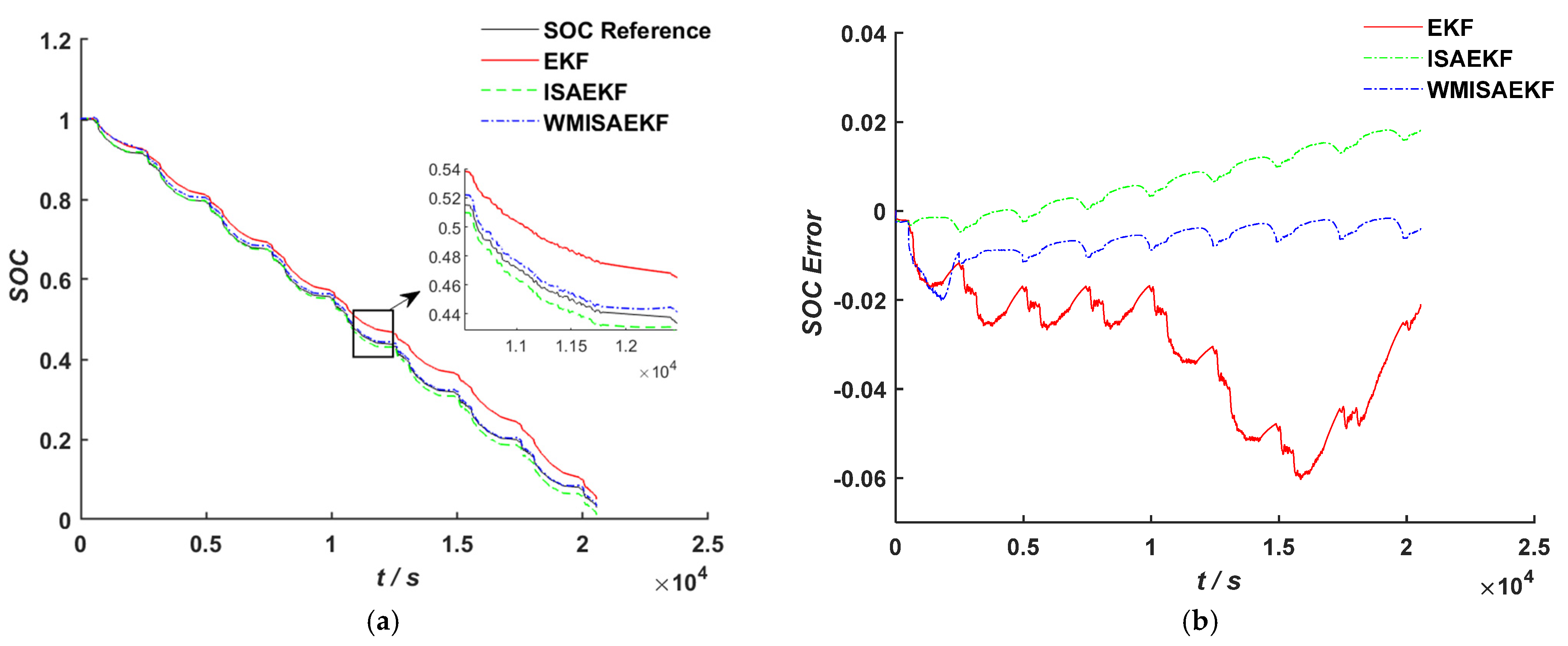1. Introduction
Against the backdrop of the global shift in energy structure in recent years, countries worldwide are accelerating their transition to green and low-carbon energy, establishing it as the dominant trend. Products such as electric vehicles and lithium-ion batteries, serving as the primary carriers of green energy, are advancing rapidly in the related industrial technologies. This progress contributes significantly to the ongoing promotion of high-efficiency and high-quality development in the green energy industry [
1,
2]. Lithium-ion batteries, which serve as the primary power source for electric vehicles, are characterized by high energy density, long service life, and excellent power performance. In BMSs, SOC represents the remaining available energy of the battery and is a key indicator of the BMS. Accurate SOC estimation plays a vital role in ensuring battery safety, enhancing overall performance, and extending the lifespan of the batteries [
3,
4]. There are inherent dynamic nonlinear characteristics in lithium-ion batteries due to the complex operating environments and the intricate electrochemical reaction mechanisms during charging and discharging cycles. Consequently, direct measurement of the SOC through external means is impractical. Therefore, the uses of model-based method and other methods are necessary for estimation and prediction to indirectly obtain SOC [
5,
6,
7]. The prerequisite for SOC prediction is based on accurate battery model parameters [
8]. Therefore, SOC estimation should comprehensively consider improving the identification of battery model parameters and enhancing the accuracy of SOC estimation.
Currently, the primary methods for SOC estimation include the ampere-hour integral method, the open-circuit voltage method, the data-driven method, and the model-based method [
9,
10]. The ampere-hour integral method is a simple calculation process, but it is prone to causing large cumulative errors [
11]. The open-circuit voltage method requires extended idle periods for batteries and imposes stringent environmental conditions; therefore, it is unsuitable for real-time estimation of dynamic working conditions. Furthermore, it is significantly affected by factors such as temperature and aging, resulting in a limited scope of application [
12]. The data-driven method relies on extensive datasets to establish mapping relationships. While theoretically capable of handling lithium batteries’ complex nonlinear characteristics using voltage and current data, the practical implementation faces significant limitations: data dependency, high computational load, poor generalization capability, substantial hardware requirements, and challenges to the real-time performance of algorithms [
13]. The model-based method simulates the dynamic characteristics of battery by establishing a robust battery model and uses a reliable state estimation algorithm for SOC estimation. The model-based method not only ensures the accuracy of battery estimation but also effectively mitigates the effects of measurement noise on the estimation process. Among the aforementioned methods, the model-based method has become the dominant technical means for SOC estimation due to its inherent advantages [
14,
15,
16]. The battery models utilized in the model-based method are mainly categorized into electrochemical models and equivalent circuit models [
17]. Electrochemical models elucidate the electrochemical reaction mechanisms of the battery through coupled partial differential equations. Although the electrochemical models provide high accuracy, they are computationally complex and exhibit limited engineering practicality [
18]. In contrast, equivalent circuit models emulate battery polarization behavior using networks of passive components, simulating external characteristics for real-time applications. Owing to their straightforward structure, computational efficiency, robust scalability, and ease of implementation in engineering, equivalent circuit models are extensively used [
19,
20,
21].
Parameter identification and optimization of the SOC estimation algorithm represent the primary technical methods for enhancing the SOC estimation accuracy of batteries. Parameter identification is the foundation for SOC estimation, with commonly used algorithms including circuit analysis, the particle swarm optimization algorithm, and least squares, along with its derivative algorithms. Chen et al. used circuit analysis as the foundation for battery parameter identification [
22]. While this method is conceptually simple, it is an offline identification approach with limited real-time performance. Guo et al. employed circuit analysis to isolate the internal resistance of the battery within a second-order RC equivalent circuit model and then applied the least squares algorithm to identify and calculate other parameters. However, the internal resistance derived from the circuit analysis exhibits significant errors, which adversely affects the accuracy of the SOC estimation to a certain extent [
23]. Ren et al. employed the particle swarm optimization (PSO) algorithm for offline parameter identification coupled with real-time adjustment of online estimation [
24], and Zhu et al. proposed a dual particle swarm cooperative optimization method for parameters identification based on an adaptive dynamic sliding window [
25]. While these approaches demonstrated a relative improvement in identification accuracy, the correction process and particle sampling significantly increased the calculation time, leading to a slow overall processing speed. Literature [
26,
27] proposed integrating the PSO algorithm with the least squares algorithm to address challenges such as particle degeneracy and resampling. However, this hybrid approach also results in algorithmic complexity. Compared to the other two algorithms, the least squares algorithm maintains a core principle: minimizing the sum of squared errors. It is an online identification method with low algorithmic complexity and rapid convergence speed. Lim et al. employed a recursive least squares algorithm for battery parameter identification to achieve a relatively high parameter accuracy that enables effective state estimation of lithium-ion batteries [
28]. However, this method exhibits susceptibility to data saturation when applied to the estimation of slowly time-varying battery parameters. Therefore, some literature has proposed incorporating the forgetting factor to enhance research outcomes. Literature [
29,
30] proposed the forgetting factor recursive least squares algorithm for parameter identification calculations in the equivalent circuit model of lithium-ion batteries. However, fixed forgetting factors undermine the simultaneous optimization of parameter identification stability and accuracy. Furthermore, excessively low forgetting factor values may induce unstable fluctuations in identified parameters. Then, scholars proposed the variable forgetting factor least squares algorithm for parameter identification. Ge et al. introduced a forgetting factor recursive least squares algorithm based on the means and standard deviations of the innovations [
31]. However, continuous computation of means and standard deviations during iterations significantly degraded algorithmic efficiency due to computational overhead. Literature [
32,
33] proposed a variable forgetting factor strategy that is adjusted in time with the change in errors in order to improve the accuracy of the parameter identification algorithm. However, the coefficient adjustment mechanism of the strategy has a significant impact on the error tracking ability of the algorithm. Improper design of the adaptation mechanism may trigger excessive parameter fluctuations, degrading identification accuracy and potentially inducing algorithm divergence. Furthermore, an improper coefficient adjustment mechanism can also critically compromise the anti-interference ability of the algorithm.
Currently, the primary model-based SOC estimation methods include the Kalman filter algorithm, the H∞ algorithm, and the sliding mode observer algorithm [
34]. The H∞ algorithm demonstrates strong robustness against noise distribution uncertainty yet incurs significant computational burden. Furthermore, its emphasis of robustness may lead to a reduction in estimation accuracy [
35,
36,
37]. The sliding film observer method has good robustness, but the problem of output jitter is an obvious drawback of this method [
38,
39,
40]. In the field of battery SOC estimation, numerous improved algorithms derived from Kalman filter (KF) theory have been extensively utilized [
41]. These improved KF algorithms, designed to address the nonlinear characteristics of lithium-ion batteries, primarily include the extended Kalman filter (EKF), untraceable Kalman filter (UKF), and cubature Kalman filter (CKF). Among them, the EKF algorithm has become a research hotspot in SOC estimation due to its advantages, such as low computational complexity, high stability, good real-time performance, and strong robustness [
42,
43]. In response to the need for improving SOC estimation accuracy, scholars have optimized the traditional EKF method in various aspects. Literature [
44,
45] proposed an adaptive EKF (AEKF) algorithm that leverages statistical characteristics of residual sequences for SOC estimation in lithium-ion batteries. Li et al. proposed incorporating the multi-innovation theory into the EKF algorithm to form the multi-innovation EKF (MIEKF) for SOC estimation [
46]. Meanwhile, other researchers have proposed combining parameter identification techniques with the SOC estimation algorithm to enhance SOC estimation accuracy in lithium-ion batteries. He et al. proposed a study of SOC estimation based on the variable forgetting factor recursive least squares algorithm for first-order RC circuit parameter identification combined with the AEKF algorithm [
47], but the accuracy of parameter identification in this method is inadequate, which directly degrades the SOC estimation accuracy. Tian et al. proposed AEKF based on second-order equivalent circuit parameter identification for SOC estimation to improve the tracking of the algorithm [
48]. Wu et al. proposed combining the multi-innovation least squares algorithm for parameter identification with the multi-innovation EKF(MIEKF) algorithm for SOC estimation to enhance the accuracy of SOC estimation in lithium-ion batteries [
49]. Nevertheless, the allocation of innovation weights is not sufficiently reasonable, which adversely impacts SOC estimation accuracy. Dong et al. implemented the multi-innovation least squares algorithm with heterogeneous forgetting factors, enabling independent adaptation rates for distinct parameters to mitigate errors in the battery model [
50]. This approach improves the model estimation accuracy; it is combined with EKF for SOC estimation. However, this algorithm necessitates decoupling the covariance matrix and gain matrix of the least squares algorithm for computation, which increases the computational workload, while the robustness of the algorithm is generally moderate.
The RLS algorithm and its improved algorithms demonstrated strong dynamic tracking capabilities in lithium-ion battery parameter identification, and the EKF and its improved algorithms showed notable advances in SOC estimation. The aforementioned studies predominantly employed adaptive forgetting factors for RLS enhancement, while the accuracy and anti-interference ability of parameter identification were limited. It is particularly difficult to maintain consistent parameter accuracy under noise interference. When used for SOC estimation, EKF-based algorithms are susceptible to diverging in cases of strong model nonlinearity or large initial errors. In addition, while the MIEKF incorporates historical observation innovations, the traditional weight allocation methods inadequately assign weights to the historical innovation values, especially ignoring the critical impact of observation error magnitude on innovation values, leading to issues such as reduced accuracy and overcorrection in the iterative process, thereby constraining the enhancement of SOC estimation.
According to the studies presented above, we propose a SOC estimation approach for lithium-ion batteries based on a second-order RC equivalent circuit model and design an improved adaptive variable forgetting factor regulation mechanism (IAFF) with wide applicability. An improved adaptive variable forgetting factor recursive least squares algorithm (IAFFRLS) is proposed for model parameter identification. This algorithm not only improves the accuracy of parameter identification but also demonstrates excellent anti-interference capabilities. On this basis, an improved method of the extended Kalman filter algorithm based on Sage–Husa adaptive filtering is proposed to solve the problem of filter divergence. Furthermore, a novel weight calculation method is designed based on multi-innovation theory, which assigns larger weight factors to innovations that are closer to the current time and have larger observation errors. This method is used to calculate the innovation weights for the improved Sage–Husa multi-innovation EKF algorithm, thereby resolving issues such as low precision and over-correction during iterations in the MIEKF. This approach not only improves SOC estimation accuracy, but also has strong robustness.
